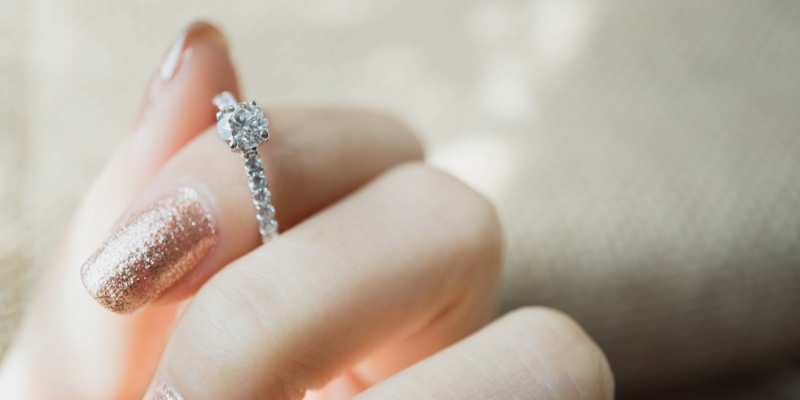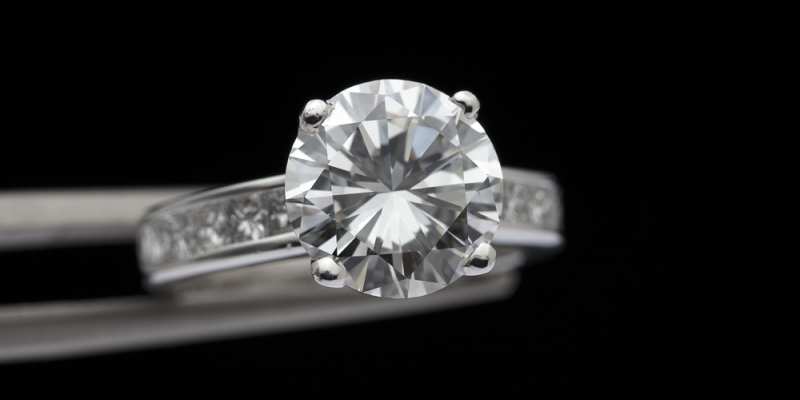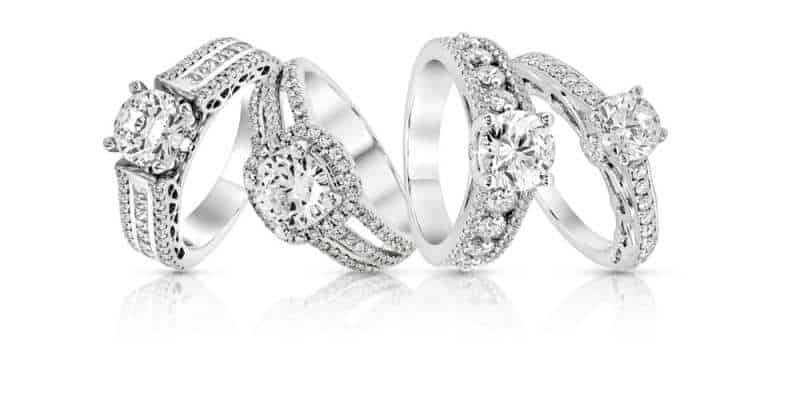A stunning diamond ring is something that can be cherished for generations. However, even the most beautiful rings can experience the unfortunate event of a lost diamond. This may leave you wondering: What are the causes of diamonds falling out of rings?
The most common reason for diamonds falling out of rings is regular daily wear. Rest assured, it happens more frequently than you might imagine. Therefore, there’s no need to panic or immediately remove your ring. Additionally, this issue can be resolved relatively easily, even if it happens again in the future.
So, continue reading this article to discover what steps you can take to protect your diamond ring in case of such an incident.
DESIGN YOUR OWN ENGAGEMENT RING: START WITH A SETTING OR START WITH A DIAMOND. IT’S REALLY UP TO YOU!

Is It Common For Diamonds To Fall Out?
Diamonds falling out of rings is a relatively common occurrence to some extent – accidents can happen. Since we use our hands for various tasks, there’s always a risk of accidentally hitting or bumping our diamond rings against hard surfaces.
To minimize this risk, it’s generally advised to remove your diamond ring when engaging in activities that require hands-on work. It’s also wise to take off the ring while washing your hands or showering, as there’s a chance the diamond could fall out and potentially go down the drain.
The security of your diamond in the ring is also influenced by the setting. Different types of settings offer varying levels of stability. For example, bezel setting and channel setting are known for their secure nature.
There are several common causes for diamonds falling out that you should be aware of. By understanding these causes, you can take measures to avoid such situations. It’s always better to be safe than sorry, right?
One common scenario is when the diamond wasn’t set properly during the jewelry-making process. This highlights the importance of purchasing jewelry from reputable jewelry stores to ensure high-quality craftsmanship.
Residue build-up underneath the stone and between the setting is another reason, although it is less likely to cause a diamond to fall out. Nevertheless, regular cleaning of your diamond ring is crucial to maintain its condition.
The most frequent cause of diamonds falling out is everyday wear and tear. Over time, the prongs holding the diamond may become looser, increasing the risk of the diamond coming loose.

How Can You Tell If The Diamond Is Loose?
To determine the condition of your diamond, it’s helpful to check if it is securely set in the ring. A loose diamond can be a cause for concern, as it may be at risk of falling out.
To test if your diamond is loose, gently move it with your finger. If you feel any noticeable movement, it is advisable to take it to the jewelry store where you purchased it. They can assess the situation and potentially reinforce the setting to secure the diamond.
Another method is to hold the diamond close to your ear and tap on the band of the ring. If you hear a rattling sound, it indicates that the diamond is either loose or becoming loose. You may choose to perform this test periodically to ensure that your diamond ring remains in good condition.

Do Pave Diamonds Fall Out More Easily?
A pave diamond ring is characterized by multiple small diamonds set closely together. The number and arrangement of these diamonds can vary. However, there is a risk of them becoming loose or falling out.
The presence of numerous diamonds in a pave setting increases the likelihood of one coming loose without immediate notice. Additionally, it may be challenging to realize when a diamond has fallen out, making it difficult to recover the stone.
Fortunately, smaller diamonds are typically easier to replace and match with new ones. However, it is understandable if you prefer to keep the original diamond. Overall, the risk of losing a diamond is somewhat higher with a pave setting.
If you happen to lose a diamond from your ring, the first step is to try and locate the stone. If you find it, it’s advisable to hold onto it. Then, you can take it to your jeweler, who can assess the situation and potentially reset the diamond in your ring.
In case you cannot find the lost stone, there are still options available to you. Firstly, check if your ring is insured. If it is, the cost of replacement may be covered by the insurance policy.
If you don’t have insurance, your next step would be to consult with a jeweler to explore the possibility of finding a matching replacement stone for your ring. They can guide you through the available options that best suit your ring.
When considering ring insurance, it’s essential to review the coverage provided by the policy. While each policy is unique, comprehensive coverage typically includes theft, repair or replacement, incidents occurring at home or away, accidental damage, and accidental loss of the ring. It’s recommended to carefully examine the coverage offered in relation to the premium you are willing to pay. Policies with higher premiums often offer more extensive coverage.
The cost of ring insurance depends on factors such as the value of your ring and the level of coverage you desire. Insurance companies employ different formulas to determine the insurance amount, and rates may vary based on your location. Typically, ring insurance ranges from 1 to 2 percent of the ring’s value. For example, if you want to insure a $5,000 ring, you can likely find coverage for around $50 per year. It’s also important to consider the deductible—the higher the deductible you choose, the lower your insurance premium will be.
To ensure you obtain the best coverage for the most favorable price, it is recommended to compare offerings from multiple insurance companies.

How To Get My Diamond Ring Insured?
Securing insurance for your diamond ring doesn’t have to be intimidating. In fact, it’s a straightforward process that can save you from the financial burden of dealing with a lost or damaged diamond. Let’s go through the steps involved:
- Review Your Home Policy: Start by checking your existing home or renters insurance policy, as it may already provide coverage for your jewelry and other valuable items. However, the coverage limit for such items is usually low, around $1000. If your diamond ring exceeds this value, you’ll likely need additional insurance.
- Obtain an Appraisal: Once you decide to pursue additional coverage, it’s important to have your diamond ring appraised. This step isn’t just about finding out the ring’s value but is typically a requirement for obtaining insurance. Keep a copy of the appraisal paperwork handy when you apply for insurance to ensure accurate coverage estimation.
- Find the Right Insurance: Now it’s time to search for suitable insurance options. You have multiple companies to choose from, including the one that designed the ring, the store where you purchased it, your homeowner’s insurance provider, or other insurance companies. Take notes and ask relevant questions before making a decision. Some key inquiries include:
- What is the deductible?
- Will re-appraisal be necessary in the future?
- How does the claims process work?
- Is the claims process complicated?
- Will you receive the full value of the ring in case of an incident?
- How is the market value of the ring determined?
- What types of damage, loss, or theft are covered?
- What is the cost of protecting the ring?
- Protect Your Diamond Ring: Even with insurance coverage, it’s important to keep your diamond ring protected. Store it in a safe place when you’re not wearing it to prevent any unfortunate incidents. Avoid making it easy for thieves by taking necessary precautions.
Will My Homeowner’s Insurance Cover Diamond Rings?
Certain homeowner’s insurance policies may cover diamond rings, especially if they are simple and not too expensive. However, traditional policies typically don’t cover rings lost outside the home. In such cases, you can explore adding an extension to your home insurance policy specifically for your diamond ring. Contact your insurance company to inquire about the cost of this extension and compare it with other diamond ring insurance providers before making a final decision.
Do I Need Diamond Ring Insurance?
The decision to insure your diamond ring ultimately rests with you. However, for more expensive rings with significant value, insurance can provide peace of mind in the event of damage, loss, or theft. Many people appreciate the comfort of knowing that their insurer will assist with expenses, repairs, or replacement if something unfortunate happens to their ring. Ultimately, the choice is yours to make.

What To Look For In Insurance Policies When Purchasing
When considering diamond ring insurance policies, it’s crucial to take certain factors into account beforehand. Here are some key aspects to consider before purchasing a policy:
- Price: Evaluate the cost of the insurance policy, which will give you an idea of the total amount you’ll need to pay over its duration. This will help you determine if the policy offers good value.
- Coverage: Review what aspects of the ring are covered by the policy. Does it provide coverage for loss, damages, or a combination of both? Some policies may also specify a dollar amount for compensation.
- Claims Process: Familiarize yourself with the claims process before signing the policy. Understand the steps involved and the complexity of the process should you need to make a claim in the future.
- Deductible: Consider the deductible amount. Typically, lower deductibles result in higher annual premiums, while higher deductibles lead to lower premiums.
- Policy Duration: Check the length of the policy and compare it with offerings from other insurance companies.
- Customer Service: Opt for a company that provides excellent customer service, as you may need their assistance during the policy period.
In conclusion, insuring your diamond ring is a wise decision to protect against potential losses. Various factors can cause diamonds to fall out of rings, including damage, residue buildup, or poor craftsmanship. Having insurance provides peace of mind in the event of unexpected incidents, such as a lost or stolen diamond.


